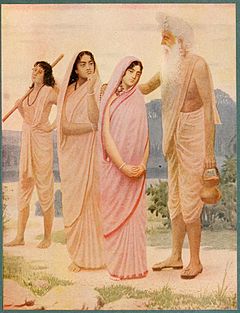Shakuntala, also known as The Recognition of Shakuntala, The Sign of Shakuntala, and many other variants (Devanagari: अभिज्ञानशाकुन्तलम् – Abhijñānashākuntala), is a Sanskrit play by Kālidāsa, dramatizing the story of Shakuntala told in the epic Mahabharata. It is considered to be the best of Kālidāsa's works.[1] Its date is uncertain, but Kālidāsa is often placed in the period between the 1st century BCE and 4th century CE.[not verified in body]
Origin of Kālidāsa's play[
Shakuntala elaborates upon an episode mentioned in the Mahabharata, with minor changes made (by Kālidāsa) to the plot.[citation needed]
Title
Manuscripts differ on what its exact title is. Usual variants are Abhijñānaśakuntalā, Abhijñānaśākuntala, Abhijñānaśakuntalam and the "grammatically indefensible" Abhijñānaśākuntalam.[2][dead link] The Sanskrit title means pertaining to the recognition of Shakuntala, so a literal translation could be Of Shakuntala who is recognized. The title is sometimes translated as The token-for-recognition of Shakuntala or The Sign of Shakuntala.[citation needed] Titles of the play in published translations include Sacontalá or The Fatal Ring and Śakoontalá or The Lost Ring.[3][4]
Synopsis
The protagonist is Shakuntala, daughter of the sage Vishwamitra and the apsara Menaka. Abandoned at birth by her parents, Shakuntala is reared in the secluded hermitage of the sage Kanva, and grows up a comely but innocent maiden.
While Kanva and the other elders of the hermitage are away on a pilgrimage, Dushyanta, king of Hastinapura, comes hunting in the forest and chances upon the hermitage. He is captivated by Shakuntala, courts her in royal style, and marries her. He then has to leave to take care of affairs in the capital. She is given a ring by the king, to be presented to him when she appears in his court. She can then claim her place as queen.
The anger-prone sage Durvasa arrives when Shakuntala is lost in her fantasies, so that when she fails to attend to him, he curses her by bewitching Dushyanta into forgetting her existence. The only cure is for Shakuntala to show him the signet ring that he gave her.
She later travels to meet him, and has to cross a river. The ring is lost when it slips off her hand when she dips her hand in the water playfully. On arrival the king refuses to acknowledge her. Shakuntala is abandoned by her companions, who return to the hermitage.
Fortunately, the ring is discovered by a fisherman in the belly of a fish, and Dushyanta realises his mistake - too late. The newly wise Dushyanta defeats an army of Asuras, and is rewarded by Indra with a journey through heaven. Returned to Earth years later, Dushyanta finds Shakuntala and their son by chance, and recognizes them.
In other versions,[relevant? ] especially the one found in the Mahabharata, Shakuntala is not reunited until her son Bharata is born, and found by the king playing with lion cubs. Dushyanta enquires about his parents to young Bharata and finds out that Bharata is indeed his son. Bharata is an ancestor of the lineages of the Kauravas and Pandavas, who fought the epic war of the Mahabharata.[relevant? ] It is after this Bharata that India was given the name "Bharatavarsha", the 'Land of Bharata'[relevant? ].[5]

No comments:
Post a Comment